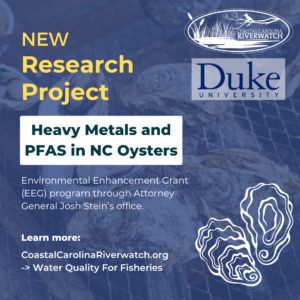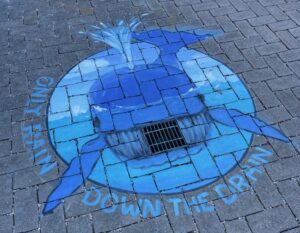The purpose of the Water Quality for Fisheries (WQ4F) Program is to identify and address the impacts of water quality on the North Carolina fisheries. So far, CCRW has completed initial survey research into the top water quality concerns of fishers and created a written assessment that outlines the concerns and gaps in water quality services that could address them.
Part of this original assessment process included collaborating with NC fishers to identify concerns and develop projects through the Industry Working Group (IWG). The IWG is made up of commercial and recreational fisheries representatives, working together to protect the quality of water and quality of life in coastal North Carolina. This year, CCRW is restarting our regular meeting to receive feedback from fishers on our upcoming projects.
Water Quality Priorities Identified by Coastal North Carolina Fisheries Representatives:
- Agriculture and Factory Farm Runoff
- Stormwater Runoff from Roads, Highways, and Parking Lots
- Industrial Pollutants
- Plastic Pollution
- Municipal Wastewater Treatment Plants and Septic Tanks
Current Fisheries Projects
CCRW’s Water Quality for Fisheries program focuses on creating and sustaining programs to address gaps in service and safeguard the health of our waters for recreational, commercial and subsistence fishing. This program is the foundation for much of our work in 2024.

Pure Farms, Pure Waters
Agriculture and Factory Farm Runoff
Coastal Carolina Riverwatch is excited to continue our Pure Farms, Pure Waters (PFPW) project in 2024! The project is funded by our partners at Waterkeeper Alliance and aligned with our ongoing Water Quality for Fisheries (WQ4F) program.
The Pure Farms, Pure Waters initiative remains a cornerstone of our commitment to safeguarding water quality in the New River. The PFPW project focuses on identifying threats to water quality and fish species posed by Concentrated Animal Feeding Operations (CAFOs) and utilizing our findings to educate communities while promoting water-friendly practices.
This year’s research includes the analysis of bacteria, DNA, nutrients and sediments in waters adjacent to CAFO spray fields. Based on these results, CCRW will be able to better identify the threats that these animal facilities have on fisheries habitat and health.

Oyster Research
Industrial Pollutants
Plastic Pollution
We are excited to introduce our upcoming project, Water Quality for Fisheries: PFAS and Heavy Metal Contamination in North Carolina Farm Raised and Wild Caught Oyster Populations, made possible through the Environmental Enhancement Grant from the NC Attorney General’s office. This project will be conducted in collaboration with Duke University and our research partners Dr. Lee Furguson and Dr. Heileen Hsu-Kim.
The project will begin a new phase of the WQ4F project and address EEG objectives by working to improve and protect water quality within the White Oak River Basin. The proposed research and outreach will expand the State’s understanding of PFAS, mercury, and heavy metals on wild caught and aquaculture oyster populations and inform future water quality restoration efforts.

Lower New River Plan
Stormwater Runoff from Roads, Highways, and Parking Lots
Municipal Wastewater Treatment Plants and Septic Tanks
The Lower New River Watershed Restoration Plan is a critical initiative to assess and address the threats posed to surface water health in the Lower New River system. This project is proudly funded by the North Carolina Land and Water Fund and is led by Coastal Carolina Riverwatch (CCRW). The goal of this project is to enhance the resilience of the lower New River ecosystem against pollution from various sources, including development, storms, and industrial activities.
Through this project, CCRW will be collecting water quality data from around the Lower New River to identify gaps in services, identify trends in contamination and develop shovel ready projects that will improve the fishability and swimability of the New River estuary. Key insight from fisheries stakeholders and other municipal entities will ensure the resulting plan is accessible and representative of all local communities.

Water Quality For Fisheries Symposium
CCRW is hosting the Water Quality For Fisheries Symposium. This event will expand on our Marine Debris Symposium to include work surrounding the top 5 water quality concerns identified by the fisheries Industry Working Group. Presenters will include researchers, state government representatives, other environmental organizations and fisheries stakeholders.
The 1st Water Quality for Fisheries Symposium will be held on October 9, 10, 11 2024. We are accepting presentation applications for the symposium – CLICK HERE TO SUBMIT YOUR CONCEPT PROPOSAL.
Harmful Algae Bloom Response Program
Stormwater Runoff from Roads, Highways, and Parking Lots
Coastal Carolina Riverwatch Algae Bloom Response Team (ABRT) includes the White Oak Waterkeeper, citizen scientists and researchers just like you. We want to encourage the reporting of algae blooms by concerned citizens who are on the water frequently and notice changes in what they see and smell.
The HAB response program will the support the collection of samples by the Waterkeeper and the identification of any algae present in the sample. If there is the presence of a harmful algae, the Waterkeeper will work with the ABRT to continue monitoring, notify fishermen and residents in the area, and create and publish outreach content about how to stay safe and how to prevent harmful algae blooms.
Ways to volunteer:
- Aerial monitoring with drones from your local waterway.
- Reporting strange odors or colors in the water.
Send these observations to: RileyL@
Want to get involved in helping your community through citizen science and advocacy, contact us at Waterkeeper@

Adopt-A-Drain
CCRW is continuing our Adopt-A-Drain program in 2024! This citizen science project is a unique initiative that combines environmental stewardship with artistic expression. Our first Art in the Park event in November 2023 kicked off this new element of the project, where we painted a storm drain, turning it into a vibrant work of art. The response was overwhelming, and we’re excited to announce our continued participation in more Art in the Park events in the future.
This citizen science project aims to connect participants across diverse communities to our stormwater systems, encouraging everyone to adopt and care for a drain in their area.Whether you’re in a rural, urban, or suburban setting, we invite you to participate and showcase the many ways stormwater reaches our waterways!
Learn more about CCRW’s marine debris initiatives on our website.
Adopt-A-Drain is possible through our partners at Duke University Marine Lab, UNC Institute of Marine Sciences, NC State University and funded by North Carolina Sea Grant.
